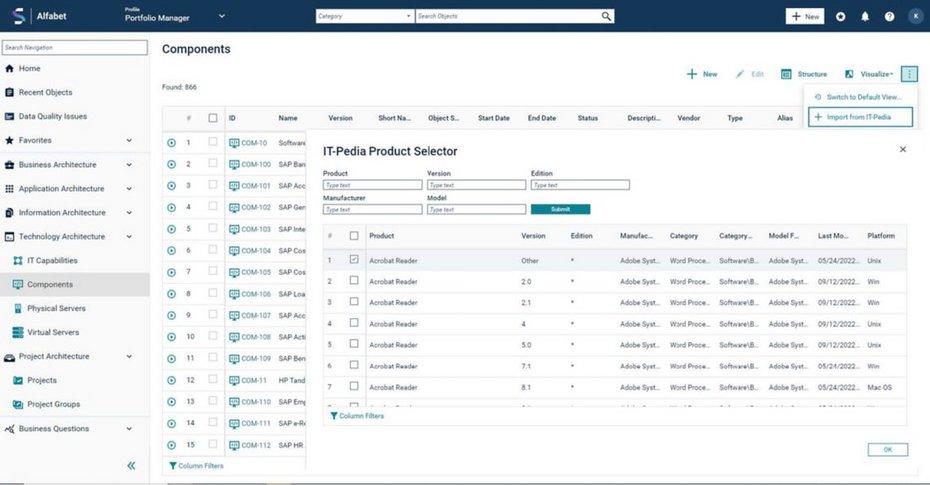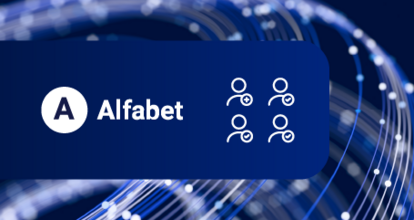Alfabet integrates out-of-the-box with IT-Pedia—the market’s definitive source for vendors, vendor products, and technology lifecycle information—so it’s easier for your stakeholders to have the latest information on the vast technologies that run your business. It’s one more way Alfabet strengthens your technology portfolio governance practice.
Better data means better decisions
The world’s smartest organizations use technology portfolio governance to:
- Provide current and reliable information on technologies in use—where and how they’re used
- Rapidly analyze the impact of technology portfolio changes on other portfolios and vice versa
- Choose, define, and enforce technology standards
- Demonstrate the costs and risks of using inadequate technologies
- Identify technology innovations that can provide the best business benefits
The challenge is that large organizations have thousands of technologies across a distributed IT ecosystem. The scope of their IT environment expands almost daily, complicating the arduous and error-prone task of keeping portfolio data standardized, correct and up-to-date. This threatens the integrity of decisions on portfolio changes.
Put those worries behind you. Alfabet for enterprise architecture and strategic portfolio management integrates out-of-the-box with the online service IT-Pedia—a comprehensive IT catalog of enterprise hardware and software products. This seamless and quick integration simplifies maintaining information on even the most complex IT portfolios and leads to greater confidence in the quality of information on your IT portfolio.

How it works
Alfabet provides an out-of-the-box connection to the IT-Pedia repository in the context of Components and Vendor Products.
Relevant data about the IT-Pedia product is imported into the Alfabet database, including attributes describing the product, lifecycle information, vendor information, product licensing and price. This information can be updated regularly with the help of a simple graphical user interface. The integration facility allows you to curate an organization-specific My Product list of technologies that can be imported into the Alfabet database.
Features
- Out-of-the-box integration for initial catalog import and subsequent updates
- Import of product and vendor attributes, such as lifecycle information, version, brand, license, price and category information
- Automatic import and update of existing technology components in the "My Product" list
- Adoption of the IT-Pedia taxonomy into Alfabet vendor and vendor product or component descriptions
- Configuration of the Alfabet selector to easily find IT-Pedia products
- Mapping of IT-Pedia attributes to custom object-class properties
- Support for Model Catalog, Procurement Catalog and My Product lists. Access to the IT-Pedia web catalog is also provided
Key benefits
- Establish a uniform language across the enterprise, making technology portfolio governance more efficient
- Save time and effort in vendor and product data collection and curation
- Be market-ready by exploring and finding new technologies for innovative digital business solutions
- Decide on IT transformation initiatives faster and with greater confidence
- Reduce the risk of compliance breaches by defining corporate standards for portfolio descriptions
- Prevent security breaches that can happen when using obsolete technology
Who benefits? Everyone
Top leaders, business area managers, procurement officers and SMEs involved in defining the technology landscape can leverage critical data points from a detailed, structured, and information-dense IT catalog to make better decisions. For example:
- CIOs and CTOs can make well-informed strategic decisions based on greater quality of technology portfolio data.
- Enterprise architects can use a corporate-wide, uniform vocabulary to establish platform standards and solution standards.
- Solution architects can request appropriate technologies by browsing through the current, up-to-date catalog of available technologies and their lifecycles.
- Vendor managers can strike better deals with existing and new vendors, as well as keep better track of vendor ratings and product lifecycles.
- Portfolio managers can initiate new standards, identify overlapping technologies that can be retired, scout for new technologies, and create a comprehensive portfolio that maximizes ROI.
- Technology owners can ensure reduced use of a matured or non-preferred technology.
- Contract managers can better manage licenses, monitor vendor performance with respect to contracts, and negotiate optimal terms and conditions.
- Risk and compliance managers can easily track if a product will soon be noncompliant, manage threats better by knowing exactly which technology is installed, and check for known threats.



